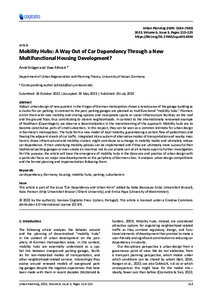Datum
2023-07-25Schlagwort
710 Landschaftsgestaltung, Raumplanung 720 Architektur DeutschlandPersonenkraftwagenAbhängigkeitRaumordnungUrbanitätParkenWohnenMobilitätMobilitätszentraleMetadata
Zur Langanzeige
Aufsatz

Mobility Hubs: A Way Out of Car Dependency Through a New Multifunctional Housing Development?
Zusammenfassung
Today’s urban design of new quarters in the fringes of German metropolises shows a renaissance of the garage building as a cluster for car parking. In contrast to the past, parking garages are planned as multifunctional “mobility hubs.” Planners enrich them with new mobility and sharing options and incorporate sports or social infrastructure facilities on the roof and the ground floor, thus contributing to vibrant neighborhoods. In contrast to the internationally renowned example of Nordhavn (Copenhagen), we observe a decentralization in the mainstreaming of the approach: Mobility hubs are to become constitutive parts of small subcenters. In this respect, they can be seen as a common leitmotiv for urban design in Germany’s metropolises. The hubs form a new model of local mobility, guaranteeing a certain flow of pedestrians and freeing the adjacent streets of car traffic. Integrated into a system of alternative modes of transportation and nearby mass transit, those infrastructural and mobility clusters might contribute to a change in mobility habits and ultimately reduce car dependence. If their underlying mobility policies can be implemented and if they are ultimately more successful than traditional parking garages or even create an incentive not to use private cars at all remains open to further investigation.
For this purpose, the article will trace the emergence of mobility hubs in the discourse and practice of urban design with a particular focus on major new developments at the periphery of German cities. It analyzes urban design competitions and the formal planning and implementation following them.
For this purpose, the article will trace the emergence of mobility hubs in the discourse and practice of urban design with a particular focus on major new developments at the periphery of German cities. It analyzes urban design competitions and the formal planning and implementation following them.
Zitierform
In: Urban Planning Volume 8 / Issue 3 (2023-07-25) , S. 112-125 ; eissn:2183-7635Förderhinweis
Gefördert durch den Publikationsfonds der Universität KasselZitieren
@article{doi:10.17170/kobra-202311038951,
author={Krüger, Arvid and Altrock, Uwe},
title={Mobility Hubs: A Way Out of Car Dependency Through a New Multifunctional Housing Development?},
journal={Urban Planning},
year={2023}
}
0500 Oax
0501 Text $btxt$2rdacontent
0502 Computermedien $bc$2rdacarrier
1100 2023$n2023
1500 1/eng
2050 ##0##http://hdl.handle.net/123456789/15147
3000 Krüger, Arvid
3010 Altrock, Uwe
4000 Mobility Hubs: A Way Out of Car Dependency Through a New Multifunctional Housing Development? / Krüger, Arvid
4030
4060 Online-Ressource
4085 ##0##=u http://nbn-resolving.de/http://hdl.handle.net/123456789/15147=x R
4204 \$dAufsatz
4170
5550 {{Deutschland}}
5550 {{Personenkraftwagen}}
5550 {{Abhängigkeit}}
5550 {{Raumordnung}}
5550 {{Urbanität}}
5550 {{Parken}}
5550 {{Wohnen}}
5550 {{Mobilität}}
5550 {{Mobilitätszentrale}}
7136 ##0##http://hdl.handle.net/123456789/15147
<resource xsi:schemaLocation="http://datacite.org/schema/kernel-2.2 http://schema.datacite.org/meta/kernel-2.2/metadata.xsd"> 2023-11-03T11:35:45Z 2023-11-03T11:35:45Z 2023-07-25 doi:10.17170/kobra-202311038951 http://hdl.handle.net/123456789/15147 Gefördert durch den Publikationsfonds der Universität Kassel eng Namensnennung 4.0 International http://creativecommons.org/licenses/by/4.0/ car dependency Germany housing mobility hubs parking suburbanism 710 720 Mobility Hubs: A Way Out of Car Dependency Through a New Multifunctional Housing Development? Aufsatz Today’s urban design of new quarters in the fringes of German metropolises shows a renaissance of the garage building as a cluster for car parking. In contrast to the past, parking garages are planned as multifunctional “mobility hubs.” Planners enrich them with new mobility and sharing options and incorporate sports or social infrastructure facilities on the roof and the ground floor, thus contributing to vibrant neighborhoods. In contrast to the internationally renowned example of Nordhavn (Copenhagen), we observe a decentralization in the mainstreaming of the approach: Mobility hubs are to become constitutive parts of small subcenters. In this respect, they can be seen as a common leitmotiv for urban design in Germany’s metropolises. The hubs form a new model of local mobility, guaranteeing a certain flow of pedestrians and freeing the adjacent streets of car traffic. Integrated into a system of alternative modes of transportation and nearby mass transit, those infrastructural and mobility clusters might contribute to a change in mobility habits and ultimately reduce car dependence. If their underlying mobility policies can be implemented and if they are ultimately more successful than traditional parking garages or even create an incentive not to use private cars at all remains open to further investigation. For this purpose, the article will trace the emergence of mobility hubs in the discourse and practice of urban design with a particular focus on major new developments at the periphery of German cities. It analyzes urban design competitions and the formal planning and implementation following them. open access Krüger, Arvid Altrock, Uwe doi:10.17645/up.v8i3.6336 Deutschland Personenkraftwagen Abhängigkeit Raumordnung Urbanität Parken Wohnen Mobilität Mobilitätszentrale publishedVersion eissn:2183-7635 Issue 3 Urban Planning 112-125 Volume 8 false </resource>
Die folgenden Lizenzbestimmungen sind mit dieser Ressource verbunden:


